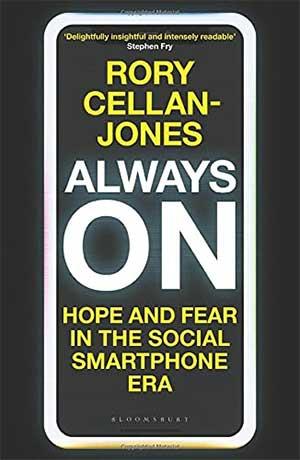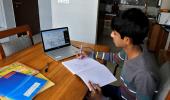The wave of enthusiasm for digital technology had faded as we'd grown more and more worried about what smartphones and social media were doing to society and to us as individuals.
Now that switchback ride between hopes for the technology and fear of it seemed to have taken us on another upward path, as the virus made us fall back in love with it.
Read on for an intriguing excerpt from Rory Cellan-Jones's Always On: Hope And Fear In The Social Smartphone Era.

With schools also closed, parents found themselves in the unenviable role of supply teachers, trying to deliver education from the kitchen table. But again technology came to their aid, with many schools using platforms like Google Classroom or Microsoft Teams to put teachers in touch with millions of pupils.
Lockdown did, however, highlight a big digital divide, both in terms of access to technology such as laptops, and in the provision of online learning.
In May a report from the Institute of Education warned that overall the amount of schoolwork being done at home was low, and there were big variations both geographically and between social groups.
Children in the north-east of England were being given about a third as much work to complete at home as those in the south-east.
Thirty-one per cent of private schools provided four or more live online lessons daily, compared to just 6 per cent of state schools. And while just about every private school pupil had access to a computer at home, one in five children getting free school meals -- a measure of a low-income household -- were in homes without any computer.
For school students at key stages there was particular anxiety, with exams on which their future depended being cancelled. Later, there were huge rows about A-Level and GCSE grades calculated by algorithms: Probably the first time algorithmic bias entered the national conversation.
In summary, lockdown was hard, desperately hard for many people, whether families with parents still trying to work while looking after children or those marooned at home alone. But the technology of 2020 did make a big diff erence to how we got through those long weeks when everything we took for granted - work, school, our social lives - was put on hold.

As I sat thinking about this that late March morning, at a time when I was in the early stages of writing this book, I wondered how we might have coped with this pandemic if it had arrived before the smartphone era.
Imagine that COVID-19 had been COVID-05, sweeping around the world in 2005. Two years before the launch of the iPhone, most people in the UK and other Western countries had a mobile phone, but it was used almost exclusively for talking and texting.
Those activities would have certainly boomed during a pandemic, but this was the era before apps. So much of what we use our phones for today would not have been possible.
Take social media, for instance. The very term would have been greeted with quizzical looks, even though many people were rediscovering old school friends via the British site Friends Reunited, which was bought by ITV in 2005.
Facebook was a year old, but was still an American college phenomenon, only arriving in UK universities in the autumn of that year. Neither Instagram nor WhatsApp had been invented, let alone Snapchat and TikTok, although YouTube was born that summer, and Twitter would come along the following year.

Back then, for just about everyone who was not a Blackberry-toting executive, the Internet and e-mail were something to be experienced on an office or home computer rather than on the move.
In the UK, about 8 million households had a broadband connection, allowing their computers to access the Internet at speeds of up to 10 megabits per second, while 7 million homes were still crawling along at dial-up speeds. That meant that all sorts of services that would later prove vital during the lockdown were only just getting off the ground.
While Skype had been started by Swedish entrepreneurs in 2003, it was for cheap Internet telephony, and video calls would not be added to the service until 2006. In fact, the whole idea of video telephones, first demonstrated at the 1964 World's Fair, had yet to become a reality at least for anyone but a few people in businesses able to afford high-end video-conferencing services.
No Zooming back then, no communing with friends using apps such as House Party, no office gossip circulating via WhatsApp or Slack or Facebook Messenger or countless other services.
As for entertainment, instead of a plethora of online services from Netflix to Spotify to the online gaming platform Twitch, we would have had to get by with good, old-fashioned broadcast TV and radio, while raiding our collections of CDs and videotapes.

Without well-developed online learning platforms, and with quite a high proportion of children having neither a computer nor a home broadband connection, delivering schooling would have been even tougher. Schools might have put a few worksheets in the post, but making sure homework was completed would have been down to parents.
While shutting down the airlines, most shops and much of the services sector did enormous damage to the economy in 2020, it would have been even worse 15 years earlier.
During the coronavirus pandemic, many people whose work involved commuting to an office found that they could operate at least as effectively from home, a development that is likely to have lasting consequences for patterns of work and transport use.
Maybe that would still have been the case in 2005, but without smartphones, video-conferencing and fast broadband connections it is difficult to see how that would have worked well for many people. It would certainly have been much harder for me to broadcast from my loft, or for us to put together an entire radio programme without going into the office.

We had very quickly become accustomed to the tools of the social smartphone era, even blasé about them, and mistrustful of the technology giants that provided them. Now we embraced them as never before, and tried to make sure elderly relatives had access to them.

The debate about the digital divide between young and old, town and country, acquired a new urgency as it became clear that fast broadband was now an essential service and, according to some, a better destination for public funds than a high-speed rail route.
The wave of enthusiasm for digital technology which in the UK had peaked around the time of the London Olympics in 2012 had faded as we'd grown more and more worried about what smartphones and social media were doing to society and to us as individuals.
Now that switchback ride between hopes for the technology and fear of it seemed to have taken us on another upward path, as the virus made us fall back in love with it.
Excerpted from Always On: Hope And Fear In The Social Smartphone Era by Rory Cellan-Jones, with the kind permission of the publishers, Bloomsbury India.
Feature Presentation: Ashish Narsale/Rediff.com










